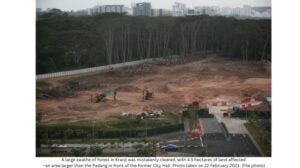Media - News
- Media
- Understanding the Law: Environmental Impact Assessments Must Not Be a Mere Formality — Confidentiality Should Not Come at the Expense of Public Participation
Understanding the Law: Environmental Impact Assessments Must Not Be a Mere Formality — Confidentiality Should Not Come at the Expense of Public Participation

Originally Published on 13 July 2025 in Lianhe Zaobao Link: 说法识法:环评不应纸上谈兵 保密也别牺牲民意
Economic development is essential to national survival—but so is the protection of our natural ecosystems. For decades, Singapore has been steadily improving its environmental impact assessment (EIA) practices in an effort to strike a balance between development and conservation. Yet, there remains room for improvement.
Key issues under public discussion include whether confidentiality agreements associated with certain EIA reports may diminish the value of public consultation; how to enhance public participation in the EIA process; and whether there is a need to enact dedicated EIA legislation in Singapore.
In this issue of Understanding the Law, legal and environmental experts explore the evolution and current state of Singapore’s EIA system, offering insights into how it might be strengthened to meet the complex environmental challenges of the future.
Environmental impact assessments (EIAs) have gained increasing prominence in Singapore’s planning processes. Since 2020, over 50 EIA reports have been published, with 11 released in just the first half of this year.
The practice of conducting EIAs emerged globally in the 1960s, aimed at deepening understanding of natural ecosystems and incorporating diverse perspectives through public consultation. The goal is to develop comprehensive mitigation strategies that minimise environmental harm from development projects.
From the 1960s to the 1980s, most commercial and public housing projects in Singapore focused primarily on ensuring geotechnical safety. In-depth environmental assessments were generally not conducted during that period.

According to research compiled by Mr. Joseph Chun, Partner at Shook Lin & Bok LLP, EIAs in Singapore were historically only conducted when deemed necessary by the authorities, and the process lacked transparency up until the 1990s.
A key milestone came in 2006, when Singapore conducted its first public consultation on the biodiversity impact of a development project—believed to be the first of its kind. A decade later, in 2016, the country undertook its first public consultation on the broader environmental impact of a proposed development.
In an interview with Lianhe Zaobao, Mr. Joseph Chun noted that Singapore’s EIA framework has evolved significantly over the past few decades. Today, EIAs generally include a public consultation phase, and developers are expected to implement the mitigation measures they commit to. He explained that the Urban Redevelopment Authority (URA) has now formalised its EIA policy, while the National Environment Agency (NEA) centrally manages EIA consultancy processes for private developers. The NEA has also issued Biodiversity Impact Assessment Guidelines to standardise assessment practices. These institutional changes have collectively contributed to strengthening Singapore’s EIA system.
Associate Professor Jolene Lin, Director of the Asia-Pacific Centre for Environmental Law (APCEL) at the National University of Singapore, Faculty of Law, remarked that Singapore’s EIA procedures have become increasingly systematic. Whereas decisions in the past were largely made internally by government agencies, the current framework includes published guidelines and opportunities for public consultation—developments she views as progress.

Assoc Prof Jolene Lin (Photo Credit: Jolene)
Ms. Raphael Goh, a member of the land use planning group at environmental organisation, LepakInSG, also observed that while Singapore’s limited land area has meant ongoing development pressure, conservation groups now have greater opportunities to participate in public consultations related to EIAs. This has allowed them to advocate for the protection of ecosystems even when development is inevitable.
Mechanisms Needed to Reflect Diverse Values in Decision-Making
Associate Professor Jolene Lin also emphasised that EIAs should not be treated merely as technical exercises or top-down bureaucratic processes.
“Any major development project should incorporate a range of information, perspectives, and value systems into decision-making,” she said. “But in order to do this meaningfully, there must be mechanisms in place to ensure these diverse voices are actually heard.”
She pointed out that in many jurisdictions, EIAs were criticised for being tokenistic or procedural, with limited influence on final decisions. For public engagement to be meaningful, Lin argued, EIA reports must be accessible and understandable, giving the public sufficient time to review them, and ideally, providing translations into different languages.
Drawing on her experience with the judicial review of the Hong Kong–Zhuhai–Macau Bridge project, Lin highlighted best practices from that case: the full EIA report was made available online, accompanied by maps, videos, and blog entries to help the public engage with the content through multiple media.
She also noted that Hong Kong operates under a “21-day framework” for EIAs, which sets a clear timeline for each stage from report publication to public consultation.
“Of course, some question whether 21 days is sufficient. That’s a separate discussion. But at least with a formalised framework, expectations and timelines are clear.”
Confidentiality Agreements in EIAs May Undermine the Purpose of Public Consultation
Public consultation is a key component of EIAs, intended to incorporate diverse viewpoints and better safeguard natural heritage. However, when EIAs are subject to confidentiality agreements, this can run counter to the very purpose of public engagement.
Of the 11 EIA reports released in the first half of this year, three were subject to confidentiality agreements. In such cases, the public is prohibited from sharing the contents of the EIA without permission, and media outlets face restrictions in reporting on the environmental impacts of the projects in question.
Ms. Kala Anandarajah, Head of the Competition, Antitrust and Trade Practice at Rajah & Tann Singapore LLP, explained that under a confidentiality agreement, no party may disclose or reproduce protected information to unauthorised individuals without prior consent.
“Typically, if an EIA is subject to a confidentiality agreement, disclosing the information without authorisation or using it for purposes outside the agreement, such as sharing with the media, could constitute a breach,” she said.
Breaches of the confidentiality agreement may give rise to civil or even criminal liability, though civil claims are more common. Ms. Anandarajah noted that such breaches may lead to lawsuits, with remedies including damages or out-of-court settlements. Criminal liability would generally only arise under statutes such as the Official Secrets Act.
While some confidentiality requirements are based on national security or other sensitive concerns, Ms. Anandarajah acknowledged that such restrictions may nonetheless weaken the effectiveness of public consultation.
“Stakeholders must have timely access to complete information in order to discuss and respond to potential environmental impacts meaningfully,” she said. “When access is restricted, both the public and the media are unable to participate fully in the consultation process. This undermines the very objective of integrating diverse perspectives into environmental decision-making.”
Experts Call for Clearer Disclosure Guidelines and a Balanced Approach to Confidentiality
Legal and environmental experts are urging the government to issue clear guidelines on information disclosure in EIAs, especially in cases where confidentiality agreements may restrict public access.
Ms. Kala Anandarajah suggested that the government consider establishing clear disclosure protocols that define when and why certain information may be withheld, along with the legal or policy justifications for such restrictions.
Ms. Raphael Goh noted that confidentiality agreements are often required before accessing EIA reports due to the sensitive location of certain projects—for example, those near military zones or involving land reclamation.
“The public must apply for access and view the reports in person at a designated location, which complicates the consultation process,” she explained. “That said, as long as national interests are involved, the need for confidentiality may be difficult to eliminate entirely.”
Associate Professor Jolene Lin added that while many countries have enacted dedicated EIA legislation, Singapore currently has no EIA-specific law. Local stakeholders have long called for such legislation, but Lin cautioned that even a formal legal framework would not mean unrestricted access to all information.
“Certain sensitive data—such as military-related content—should not, and need not, be included in EIA reports,” she said. “The focus of an EIA should remain on assessing the environmental impacts of a project and identifying the mitigation measures to be implemented.”
Astrid Puentes Riaño, the UN Special Rapporteur on human rights and the environment, made similar observations during a recent visit to Singapore. In an interview with Lianhe Zaobao, she acknowledged that confidentiality may be justifiable when national security is at stake but stressed that the scope of such protection should be clearly defined and limited.
“In other words, information about environmental impacts that does not pertain to national security should be publicly available,” she said.
Puentes also responded to the view that the average person may not be especially interested in EIA reports, and therefore confidentiality may have little real impact on public consultation. “That logic assumes the government can decide on behalf of the public what is—or isn’t—worth their attention. But such decisions should not rest solely with the state,” she said.
She added that no government, however capable, can be omniscient, and public consultation plays a crucial role in filling knowledge gaps and enhancing the quality of environmental governance.
Debate Continues over the Need for a Dedicated EIA Law in Singapore
While Singapore has steadily improved its EIA procedures, the country still lacks dedicated EIA legislation. Whether such a law is necessary remains a central topic of discussion among local conservation groups and environmental advocates.
Mr Joseph Chun noted that many countries have already enacted EIA-specific legislation, making it a widely accepted international standard. In Singapore, several environmental organisations have advocated for codifying EIA requirements into law.
“Globally, it is increasingly recognised that access to a healthy environment is a human right, which includes the right to environmental information and to participate in decision-making,” he said.
However, Ms. Kala Anandarajah argued that mandatory EIAs may not be necessary in Singapore’s context, even if they are legally required elsewhere.
“Singapore’s current system already ensures that developers complete EIAs within a defined timeline,” she said.
Ms. Raphael Goh disagreed, stating that only through mandatory EIAs can there be consistency across all development projects.
“Some agencies are more proactive in engaging with conservation groups. Legislation could require all agencies to maintain a baseline level of dialogue with conservation stakeholders, rather than leaving it to their discretion,” she said.
She also called for greater transparency in the post-EIA phase, particularly in the implementation of environmental management and monitoring plans.
“These plans are not always shared with conservation groups. We often don’t know what mitigation measures developers eventually adopted, or whether the suggested actions were properly carried out.”
Goh added that understanding EIA reports is a learning process, often requiring familiarity with Singapore’s biodiversity. However, the general public can and should participate in consultations, especially for projects located near their homes or in familiar environments.
Analysis: EIA Reports Should Be Accessible—Bridging the Gap Between Experts and the Public
What would encourage greater public participation in EIA consultations? Ms. Raphael Goh believes that improving public awareness of biodiversity and ecosystem services is key. “Only with this understanding will people become more sensitive to the potential ecological impacts of development projects.”
Associate Professor Jolene Lin agreed, adding that if EIA reports remain dense and difficult to read, it will be difficult to generate public interest. “In many countries, the introduction of EIA legislation has helped bridge the divide between experts and the public. Once information becomes more accessible, public engagement becomes more likely.”
UN Special Rapporteur Astrid Puentes Riaño also expressed hope that EIA processes around the world will become more transparent and comprehensible. She plans to submit a report to the United Nations in October, setting out what an ideal EIA process might entail, with the aim of providing guidance and direction for improving practice globally.
This is a translation by APCEL of the article, 环评不应纸上谈兵 保密也别牺牲民意 , that first appeared in Lianhe Zaobao on 13 July 2025.

